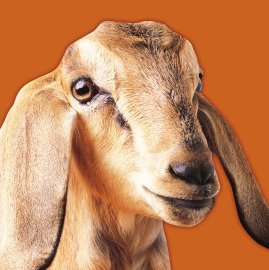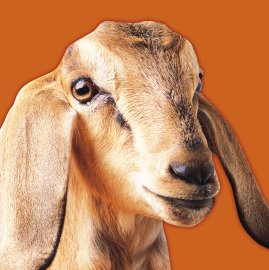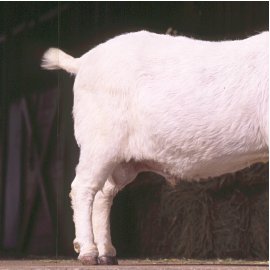
The Circular Health Check for Goats
 An important part of properly caring for your goats is being able to distinguish when they’re unhealthy and need some extra care. Many ailments can be caught and then treated by performing a simple visual inspection of your animal with the Circular Health Check about once a week. As its name implies, the Circular Health check starts at the top of the goat and goes all the way around.
An important part of properly caring for your goats is being able to distinguish when they’re unhealthy and need some extra care. Many ailments can be caught and then treated by performing a simple visual inspection of your animal with the Circular Health Check about once a week. As its name implies, the Circular Health check starts at the top of the goat and goes all the way around.
STOP 1—HEAD
Eyes - A goat’s eyes should be bright and clear. If they’re watery, runny, red, or filled with mucus, there could be problems.
Nose - The nose should be soft, wet. Watch out for any discharge or a dry or cracked nose.
Ears - Be on the lookout for mites, excessive buildup of dust or dirt or other mangy looking things.
Mouth - A goat’s mouth can have problems similar to a human’s mouth. Their gums should be pinkish, not red, inflamed, or bleeding. You may also be able to smell an infection on their breath. Although a goat’s breath will smell like the grains, flowers, or other feed they are eating, a particularly rotten smell may call for a deeper inspection. Checking out a goat’s mouth is very necessary because of the things they eat or chew on that can puncture their gums and cause an infection.
STOP 2—BASE OF THE BODY
Hair - Working your way back along the body, notice your goat’s skin and hair. Their skin should be bright and pliable. Hair should look as it normally does. Any sections of missing hair could have been rubbed off by the goat because of parasites. Missing or thinning hair could also be a sign of mineral deficiency.
Tail - Check a goat’s tail for hair loss and make sure it isn’t infected.
STOP 3—BACK AND BOTTOM OF THE BODY
Anus - Make sure you’re checking under the tail at your goat’s anus. Dry fecal matter could mean diarrhea. The feces should be normal round pellets and
not loose or runny.
Specific cautions:
Rectal or vaginal prolapse— Prolapse is when the inner organs get out of place and begin to fall out of the anus or the vagina. If a doe has had a difficult time having a kid, be particularly aware of vaginal prolapse. Also watch for infections resulting in discharge from the vagina. These issues could cause fertility issues down the road.
Mastitis - Mastitis is an infection inside of the mammary gland. The teats will be red and sore. Your goats may also have clots of infection coming out in the milk. Even if you’re not milking
your goats, mastitis is something to be aware of.
Urinary Calculi - Male goats are more likely to have urination problems, so watch them to see if they are straining to urinate. This is likely a sign of urinary calculi, stones in the urinary tract.
STOP 4—LEGS AND HOOVES
Legs - Their legs should be straight with an easy, normal gait.
Hooves - Goats’ hooves should be pliable and strong and not brittle or cracked. Also check their toes, which may need a trimming. If your goats are primarily on soft surfaces they may
need a trim once a month.
THE OVERALL PICTURE
Always be aware of the way your goats are moving and acting. If they’re less lively than normal and keeping their head down, it is a sign they’re not feeling 100 percent. After you’ve gotten used to doing regular visual checks on your goats, it will become second nature. You’ll become used to your animal’s normal appearance and should ask yourself if anything looks different. If you do identify a problem with your goat, be sure to speak with your veterinarian right away to avoid and further problems.
